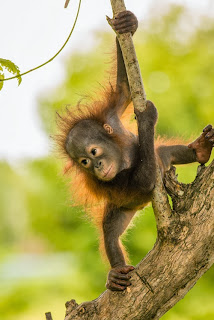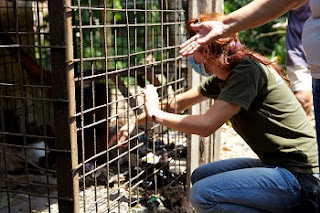The IAR Indonesia centre in Ciapus, Bogor currently has 81 lorises
consisting of 3 species – Nycticebus Coucang, N. Javanicus and N. Menagensis -
rescued from pet owners and housed for rehabilitation and subsequent release.
 I was very
fortunate to have the opportunity to carry out behavioural studies as part of
my dissertation on the captive lorises at the centre.
I was very
fortunate to have the opportunity to carry out behavioural studies as part of
my dissertation on the captive lorises at the centre.
The Loris
Project at the centre is a multi-dimensional one. A controversial and current
problem with the illegal pet trade is the hunting of lorises from the wild and
selling them in markets which are not suitable for any animals let alone
endangered species. Apart from the conservation aspect, the cruelty towards
these species in the market before they are sold is of great concern to people
working in the field of rescue and rehabilitation. IAR Indonesia not only deals
with the immediate problem of rehabilitating confiscated individuals, but also
deals with other aspects of this trade, such as awareness-building among
students and the public in major cities, in local villages around loris
habitats; conducting interviews with people involved in different aspects of
the trade; scouting for suitable release locations and monitoring those
released from the centre.
 |
| Outreach work in Bogor |
I worked
with animals at the centre and therefore I can shed some light on this aspect
of the work being done. The animals at the centre are confiscated at different
ages. Some animals were born at the centre whereas some come in as juveniles or
adults. The process of rehabilitation of species such as lorises can be tricky.
The lack of abundant research on these species, the fact that they are
nocturnal, sensitive to diseases, of small body size, possessing a different
social repertoire from other diurnal primates and their coping strategies in a
captive environment all make them difficult species to manage. However, in my
view IAR Indonesia succeeds in managing them in the best possible way within
those obvious constraints.
 |
| Erwin eating gum enrichment |
The lorises
are housed in cages, provided with trees, foliage, branches and twine in order
to create a variety of substrates for locomotion, sleep and to be able to
express as natural behaviour as possible. They are fed twice a day with a
pre-set nutritional diet planned by the on-site veterinarians, with special
attention given to those that are suffering from health problems and
mother-infant pairs.
For the
purpose of rehabilitation, International Animal Rescue ensures the following:
·
Arboreal
o
As
these species are arboreal, all the food and water trays are placed at a height.
o
Sleeping
sites, such as bamboo hollows and baskets are hung from the top of the cages.
o
Routine
replacement of leaves and branches is carried out to make the cages suitable
for the animals.
·
Insectivorous
and frugivorous
o
Diet
consisting of insects and fruits is provided. Every meal (fed twice in their
active period) consists of different fruits and insects to avoid boredom and to
provide them with their nutritional requirements.
o
The
food is placed at a considerable height from the ground to encourage feeding at
heights and minimise foraging on the ground.
Enrichment
o
All
enrichment provided is food related. Enrichment is provided to the animals
after the second meal, to encourage activity and discourage unwanted behaviours
such as stereotypies and inactivity throughout the rest of their active period.
·
Grouping
o
The
animals are grouped 2, 3 or 4 per cage depending on the cage size. Some cages
have only a single loris depending on the type of social interactions with
other conspecifics.
o
The
groups are created according to the sex of the individuals, the type and amount
of social interaction with others and depending on whether they are release or
non-release candidates.
o
In
my view, this aspect in the process of rehabilitation is vital, as
socialisation is vital to the physical and mental welfare of an animal.
·
Sanctuary
o
The
lorises that are to be released are housed in sanctuary cages. These cages are
larger in size, have more foliage and trees and are partially covered by a
roof. This is another very important point in rehabilitation, to get the
animals accustomed to natural weather conditions and changes. The cages also
have fruit trees to encourage foraging and reduce the dependency on the food
provided to them.
An
enthusiastic and motivated group of people manage the animals at the centre. My
experience of working closely with them has shown that they know a lot about
the individual animals and are keen to look after their welfare. It was
interesting to see that they were also interested in different ways of creating
enrichment that would reduce stereotypies in some of the individuals. The team
is involved in cleaning, feeding and observing the animals. One to be released
and 2 non-release animals are taken as focal animals and behavioural
observations are recorded for 1 and 2 hours respectively every night, using an
ethogram of social, individual and locomotory behaviours.
What could
be worked on at the centre?
-
The
movement of animals between cages - this is an important point as moving an
animal from one cage to another could be stressful at many levels, such as
forming new social bonds, getting used to the cage and its features, novel
interactions, unfamiliarity. All of these could lead to behavioural problems.
Another aspect is the welfare of the individuals present in the cage into which
a new individual is introduced. Depending on the sex, age and the social
ranking of the introduced individual, the form of interaction with the others
may have an impact and may lead to negative interactions, resulting in injuries
or stereotypic behaviour. The movement of individuals must therefore be done
with a lot of care and understanding of the situation. The reason for movement
should also be considered - Is the shift necessary or is there a way of dealing
with the problem through any other methods? (eg enrichment, changing amount of
foliage, substrates for locomotion – depending on the problem.) If a shift is
made, then the animal shifted, as well as the animals originally present in the
cage, must be observed for behaviour, food intake, interactions etc.
-
Increase
height of cages - this is a problem that is difficult to deal with as the cages
have already been established and have animals in each one of them. If the
purpose is rehabilitation and lorises in the wild frequent trees up to 30 to 40
m in height, a similar opportunity must be provided at the centre as well, to
avoid problems of predation for foraging too low after release. The height of
the cages currently ranges from 2m to 8m (sanctuary). Since animals spend only
a short time in the sanctuary cages before release, it is not sufficient for
them to learn to use such heights.
-
Enrichment
that is currently based only on food is effective but only for the period of
time the enrichment lasts. Some of the enrichment lasts for a very short period
or is not of interest to some individuals who spend a large proportion of their
active period carrying out stereotypical behaviour. Introducing locomotory
enrichment or finding a solution to discourage or reduce stereotypy is vital in
the process of rehabilitation as well. A good way to go about it is in some
cases to figure out the reason for stereotyping. Some tend to stereotype most
before feeding and reduce stereotypic behaviour after being fed, some
stereotype in the presence of a dominant conspecific, others during feeding
which could be a result of the type of food or the competition in the cage for
food. In others that stereotype for more than 50% of their active time, the
reasons could be past experiences or small home range or reasons that cannot be
determined, thus using some form of enrichment, trying to introduce/change the
conspecific in the same cage or shift cages may be helpful.
In my opinion, the centre is making great
efforts to turn around the current situation in the best way possible. Although
there are areas that can be explored further, new ideas implemented and changes
made to various aspects of the project, in my view the current project on the lorises
deals with the situation holistically. Working with species like lorises has
many constraints that are challenging but the centre manages to tackle a number
of them and provide rehabilitation for those rescued which has been proven to
be effective. The centre is also successfully returning a number of the lorises
to their rightful home in the wild!
 |
| Returning a slow loris to the wild |
For more information on the work International Animal Rescue does with slow lorises, please visit our website!
 Rika is about three years old and her owners said they had been keeping her for the last three months, but we suspect she has been a pet for much longer as she is very habituated to people. Her last owner had paid about $50 for her and implied that he would like money for handing her over to us. But we will never pay for an orangutan because it only encourages the trade in them.
Rika is about three years old and her owners said they had been keeping her for the last three months, but we suspect she has been a pet for much longer as she is very habituated to people. Her last owner had paid about $50 for her and implied that he would like money for handing her over to us. But we will never pay for an orangutan because it only encourages the trade in them. 
































